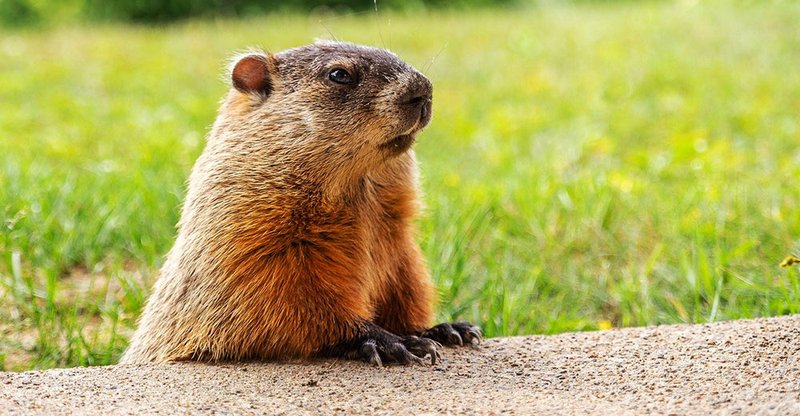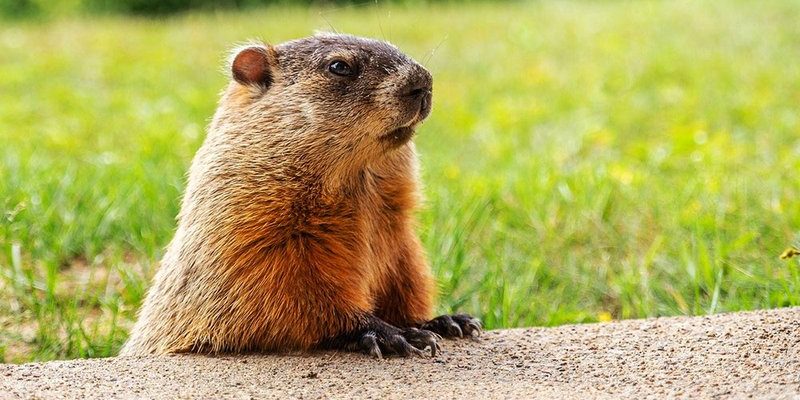
Groundhogs, also known as woodchucks, are charming little creatures that belong to the marmot family. These adorable rodents can be found in various parts of North America, from Canada down to the eastern United States. Picture a chunky, furry animal with a bushy tail and little paws—this is what a groundhog looks like! They tend to spend most of their time digging out burrows and munching on grasses and vegetables, making them quite the garden enthusiasts.
You might be wondering about their behavior. Groundhogs are known for their playful personality. They have a laid-back vibe and a curious nature, often seen dashing about or standing upright to inspect their surroundings. While they can be social, they usually prefer to live in solitude or with family members, especially during the breeding season.
Physical Characteristics of Groundhogs
Groundhogs are sturdy creatures, typically weighing between 5 to 14 pounds, depending on their age and food supply. They have a stocky build, with short legs and a round body that’s covered in dense fur. Their fur is generally a mix of brown, gray, and black, which helps them blend in seamlessly with the environment. This coat serves both as insulation and camouflage against predators.
One of their most striking features is their strong, curved claws. These are not just for show; they’re powerful digging tools! Groundhogs can dig extensive burrows that can be up to 30 feet deep and 50 feet long. This impressive underground system consists of chambers for sleeping, nesting, and even a bathroom area. Talk about a cozy home!
Groundhog Behavior and Habits
Groundhogs are generally diurnal, meaning they’re active during the day. You’ll often spot them foraging for food in the early morning or late afternoon. Their diet is predominantly herbivorous, consisting of grasses, berries, and even some flowers. However, they can be notorious for raiding gardens, munching on everything from lettuce to carrots. It’s no surprise that many gardeners consider them pests!
In terms of social structure, groundhogs are pretty interesting. They tend to be solitary, with males and females coming together only during the breeding season in early spring. After mating, females will build a nest and give birth to a litter of anywhere from two to six pups. These young ones are weaned after about a month and typically leave the burrow by the end of summer, heading out to find their own territory.
Habitat and Range
Groundhogs prefer habitats that offer ample vegetation, so you’ll often find them in fields, meadows, and even suburban backyards. They thrive in areas where they can dig, burrow, and feast on plenty of greens. Their burrows provide safety from predators like hawks, coyotes, and foxes, and help regulate their body temperature.
In terms of range, groundhogs are commonly found throughout the eastern United States and Canada. Their population has remained stable, but habitat destruction poses a potential threat. Keeping their living spaces intact is crucial for their survival and the ecological balance of the areas they inhabit.
Groundhog Day: The Most Famous Groundhog
Groundhog Day is a fun tradition celebrated every February 2nd. It’s all about Punxsutawney Phil, the most famous groundhog in the world. According to folklore, if Phil sees his shadow, we can expect six more weeks of winter; if he doesn’t, spring is just around the corner. Thousands of folks gather in Punxsutawney, Pennsylvania, to witness this annual spectacle.
The event has become a quirky cultural phenomenon, blending animal behavior with community celebration. While the accuracy of Phil’s predictions is debatable, the excitement around the day certainly brings people together. It’s a delightful reminder of our connection to nature, even in the middle of winter.
Interesting Facts About Groundhogs
| Size: | 10 to 30 inches long |
| Weight: | 5 to 14 pounds |
| Lifespan: | 3 to 6 years in the wild |
| Diet: | Herbivorous (grasses, berries) |
| Habitat: | Fields, meadows, and gardens |
| Social Structure: | Generally solitary |
Groundhog Conservation Status
Fortunately, groundhogs are not currently considered endangered. Their populations are stable thanks to their adaptability to various environments. However, it’s essential to remain aware of their habitats. Urbanization and agricultural expansion can lead to loss of space for these creatures, which may eventually impact their numbers.
Conservation efforts focused on maintaining natural spaces can help ensure that groundhogs and other wildlife continue to thrive. Supporting local conservation initiatives and raising awareness about the importance of wildlife can contribute to a healthier ecosystem for everyone.
Groundhogs in Popular Culture
Aside from their famous day in February, groundhogs have made their way into various aspects of popular culture. From cartoons and movies to children’s books, these furry creatures have captured our hearts. They often symbolize the arrival of spring and the idea of weather prediction, adding a fun twist to storytelling.
In addition, groundhogs are sometimes featured in educational settings, helping kids learn about wildlife conservation and nature. This focus on grounding young minds in environmental awareness can contribute to the appreciation of these adorable rodents, ensuring future generations value their role in the ecosystem.
How to Coexist with Groundhogs
If you live in an area where groundhogs are common, you might find them visiting your garden. Here are a few friendly tips for coexisting with these furry neighbors:
- Fencing: Securely fence off your garden to keep groundhogs from nibbling on your plants.
- Repellents: Consider using natural repellents like garlic or castor oil to deter them.
- Encourage Predators: Attracting natural predators like hawks can help control the groundhog population.
Remember, groundhogs are just trying to survive! Taking a gentle approach can help you maintain peace with these delightful creatures.
FAQ
What do groundhogs eat?
Groundhogs are herbivorous animals, primarily feasting on grasses, clovers, and dandelions. They love vegetables too, so you’ll often find them munching on plants like lettuce, carrots, and peas. In the wild, they might also snack on fruits and berries, adding a healthy variety to their diet.
Are groundhogs good diggers?
Absolutely! Groundhogs are exceptional diggers, capable of creating extensive burrows with multiple chambers. Their strong claws help them dig through soil efficiently, which is essential for their survival as it provides shelter from predators and harsh weather conditions.
How long do groundhogs hibernate?
Groundhogs typically hibernate for about 4 to 5 months. They usually enter hibernation in late autumn and emerge in early spring as temperatures begin to rise. During hibernation, their body temperature and metabolism drop significantly, allowing them to conserve energy until they can find food again.
Do groundhogs have any natural predators?
Yes, groundhogs face threats from various predators, including hawks, foxes, coyotes, and domestic dogs. Their burrows provide a means of escape and safety from these potential dangers. However, they are still vulnerable, especially when out in the open foraging for food.
Can groundhogs be kept as pets?
While it might sound cute to have a groundhog as a pet, it’s not advisable. They are wild animals that have specific dietary and environmental needs. Additionally, they can be quite territorial and may not adapt well to being kept indoors. It’s best to admire them from a distance in their natural habitats.
How fast can groundhogs run?
Groundhogs can be surprisingly quick when they need to be! They can sprint at speeds of up to 20 miles per hour in short bursts, especially when trying to evade predators. Their speed, coupled with their ability to hide in burrows quickly, helps them stay safe in the wild.
Are groundhogs social animals?
Groundhogs are generally solitary creatures. They prefer to live alone except during breeding season when they may come together for mating. Female groundhogs will also stay with their young pups until they are old enough to fend for themselves, usually by late summer.
What is the biggest threat to groundhogs?
The biggest threats to groundhogs include habitat loss due to urbanization and agriculture, as well as predation from animals like hawks and coyotes. Keeping their natural spaces intact is vital for maintaining their populations and ensuring these delightful rodents continue to thrive.

